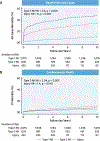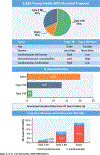Cardiovascular Mortality After Type 1 and Type 2 Myocardial Infarction in Young Adults
- PMID: 32138959
- PMCID: PMC7382936
- DOI: 10.1016/j.jacc.2019.12.052
Cardiovascular Mortality After Type 1 and Type 2 Myocardial Infarction in Young Adults
Abstract
Background: Type 2 myocardial infarction (MI) and myocardial injury are associated with increased short-term mortality. However, data regarding long-term mortality are lacking.
Objectives: This study compared long-term mortality among young adults with type 1 MI, type 2 MI, or myocardial injury.
Methods: Adults age 50 years or younger who presented with troponin >99th percentile or the International Classification of Diseases code for MI over a 17-year period were identified. All cases were adjudicated as type 1 MI, type 2 MI, or myocardial injury based on the Fourth Universal Definition of MI. Cox proportional hazards models were constructed for survival free from all-cause and cardiovascular death.
Results: The cohort consisted of 3,829 patients (median age 44 years; 30% women); 55% had type 1 MI, 32% had type 2 MI, and 13% had myocardial injury. Over a median follow-up of 10.2 years, mortality was highest for myocardial injury (45.6%), followed by type 2 MI (34.2%) and type 1 MI (12%) (p < 0.001). In an adjusted model, type 2 MI was associated with higher all-cause (hazard ratio: 1.8; 95% confidence interval: 1.2 to 2.7; p = 0.004) and cardiovascular mortality (hazard ratio: 2.7; 95% confidence interval: 1.4 to 5.1; p = 0.003) compared with type 1 MI. Those with type 2 MI or myocardial injury were younger and had fewer cardiovascular risk factors but had more noncardiovascular comorbidities. They were significantly less likely to be prescribed cardiovascular medications at discharge.
Conclusions: Young patients who experience a type 2 MI have higher long-term all-cause and cardiovascular mortality than those who experience type 1 MI, with nearly one-half of patients with myocardial injury and more than one-third of patients with type 2 MI dying within 10 years. These findings emphasize the need to provide more aggressive secondary prevention for patients who experience type 2 MI and myocardial injury.
Keywords: myocardial injury; outcomes; troponin; type 2 myocardial infarction; young adults.
Copyright © 2020 American College of Cardiology Foundation. Published by Elsevier Inc. All rights reserved.
Figures




Comment in
-
The Gloomy Long-Term Prognosis of Patients With Type 2 Myocardial Infarction or Myocardial Injury.J Am Coll Cardiol. 2020 Mar 10;75(9):1014-1016. doi: 10.1016/j.jacc.2020.01.004. J Am Coll Cardiol. 2020. PMID: 32138960 No abstract available.
-
Definition of Type 2 Myocardial Infarction and its Impact on Prognosis.J Am Coll Cardiol. 2020 Jul 21;76(3):352-353. doi: 10.1016/j.jacc.2020.03.087. J Am Coll Cardiol. 2020. PMID: 32674802 No abstract available.
-
The Prognostic Yield of Type 2 Myocardial Infarction.J Am Coll Cardiol. 2020 Jul 21;76(3):353. doi: 10.1016/j.jacc.2020.03.089. J Am Coll Cardiol. 2020. PMID: 32674803 No abstract available.
-
Type 2 Myocardial Infarction and Injury: Is the Poor Heart the Culprit or Collateral Damage?J Am Coll Cardiol. 2020 Jul 21;76(3):353-354. doi: 10.1016/j.jacc.2020.03.088. J Am Coll Cardiol. 2020. PMID: 32674804 No abstract available.
-
Reply: Type 2 MI and Myocardial Injury in Young Adults.J Am Coll Cardiol. 2020 Jul 21;76(3):354-356. doi: 10.1016/j.jacc.2020.05.047. J Am Coll Cardiol. 2020. PMID: 32674805 No abstract available.
References
-
- Thygesen K, ALpert JS, Jaffe AS, et al. Fourth universal definition of myocardial infarction (2018). J Am Coll Cardiol 2018;72:2231–64. - PubMed
-
- Diaz-Garzon J, Sandoval Y, Smith SW, et al. Discordance between ICD-coded myocardial infarction and diagnosis according to the universal definition of myocardial infarction. Clin Chem 2017;63:415–9. - PubMed
-
- McCarthy CP, Vaduganathan M, Januzzi JL Jr. Type 2 myocardial infarction-diagnosis, prognosis, and treatment. JAMA 2018;320:433–4. - PubMed
Publication types
MeSH terms
Grants and funding
LinkOut - more resources
Full Text Sources
Other Literature Sources
Medical

